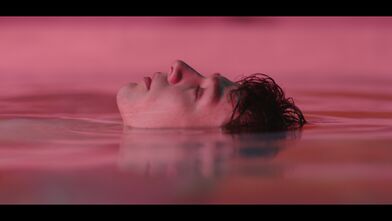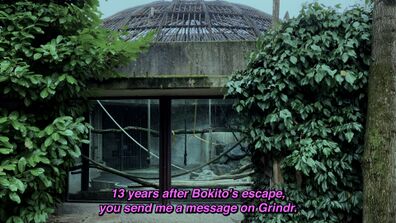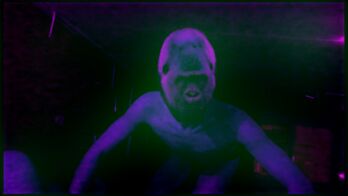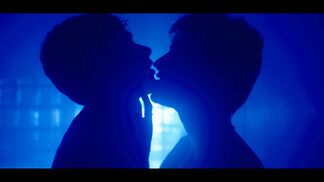LauText: Difference between revisions
No edit summary |
|||
| (24 intermediate revisions by the same user not shown) | |||
| Line 1: | Line 1: | ||
== | == '''''Text on Practice''''' '''''[[User:Laurenszautsen|Lau]] (Laurens) Zautsen''''' == | ||
[[File:Still 'Release' 1.jpg|thumb|392x392px|Still 'Release' ]] | |||
=== '''What have you been making?''' === | |||
During the past months I have been working on different projects. I’m finishing my short fiction ‘[[User:Laurenszautsen/RELEASE|Release]]’. This film focuses on the experiences of a young boy, Bo (18), entering a gay-sauna for the first time. In the film Bo learns the do’s and don’ts of cruising in a highly sexual space by simply doing and exploring through multiple visits. | |||
My most recent work while attending this master's program is the short film '[[My private bokito|There's Something Behind Glass]]', which was made for the EYE filmmuseum research-lab. It's a visual essay that compares a personal story to a news event, in this case a grindr date that never happened and the escape of silverback gorilla Bokito in the Rotterdam zoo. The film is in my opinion a stream of consciousness, since it portrays an associative thought process. | |||
=== '''How did you make it?''' === | |||
When I start a project, mostly the first inspiration comes from a particular feeling or observation from life itself. A lot of the time I start from emotion, from something abstract I feel that is quite particular, but also has a certain universality regarding the human experience. This is also the beginning of the two short films mentioned above. | |||
Next I try to find theories that elaborate on this personal sensation. My research is mostly project-based. In ‘There’s Something Behind Glass’ a central event was the escape of the gorilla that happened back in 2007 at Blijdorp. So I read multiple passages from Aad Wagenaars’ ‘Bokito’ in which he unfolds a detailed description of the day he escaped. This gave me more insight into which elements of the event I wanted to use for my own story. | |||
[[File:Still 'There's Something Behind The Glass' 1.jpg|left|thumb|396x396px|Still: 'There's Something Behind Glass' ]] | |||
Thematic-wise I wanted to dive deeper into the concept of desire. I took a closer look at Jacques Lacan's notion of ''objet a'' (Lacan, 1957-1958). This idea became a starting point for shaping the psychology of the film. | |||
I was fascinated by this idea of an unconscious need to have a desire that will always be out of reach, an obsession we project on multiple persons who can’t answer our feelings. Because when our fantasy becomes too real, it only seems to do harm and the dream vanishes. That’s where Bokito comes in, I found the notion of an entity behind glass a good metaphor for this concept. | |||
This film arised by collecting material and starting with an edit. In this way I did research by creating. I started with finding and makingimages that carried certain aspects of the story or carried a feeling. I made my own shots with various gear or searched through archival material, both personal and public, I did a lot of freewriting of poetry and I made a first (chaotic) edit. By then it was clear to me what the form of the film would be, also because of the theoretical research. | |||
So I rewrote and recorded the voice-over which became fundamental for the structure of the film. The next step was matching images with certain parts of the text and sound-design.` | |||
=== '''Relation to previous practice.''' === | |||
[[File:Still 'There's Something Behind Glass' .jpg|thumb|348x348px|Still 'There's Something Behind Glass' ]] | |||
In my practice writing is a steady part of the process. Whether it’s a solid script, a voice-over or poetry; a lot of ideas start for me from words. But at the same time I try to make visual work that carries meaning in the image itself. ‘Release’ doesn’t contain any dialogue. The film is focused on the non-verbal communication of the act of cruising and shows its story through ambience and tension. | |||
Regarding ‘There’s Something Behind Glass’, for me working in this personal, essayistic way is different from the work I used to produce. During my bachelor's I was primarily focused on documentary and fiction moving images in a traditional way in the role of a writer and director. These were films that represented a certain message in scenes and through characters and not directly addressed one’s own thoughts. | |||
[[File:Still 'Release' .jpg|left|thumb|324x324px|Still 'Release' ]] | |||
‘Release’ is a good example of this practice. It’s a film that’s quite traditionally fiction that started with a script, then shooting and then post. I was merely the writer/director and operated within a big crew of people, each working on their own department. | |||
In the project for the eye, I chose to operate on a more individual level, handling everything from script to camera, edit and sound. This allowed me more creative freedom, although it also posed its own set of challenges. Nevertheless, this approach has given me the ability to evolve as an autonomous artist. | |||
‘There’s Something Behind Glass’ also never had these clear stadia of production that were very much apart from each other. The writing happened through the editing. | |||
=== '''What do you want to make next?''' === | |||
[[File:Performance Kaleido.jpg|thumb|347x347px|Photograph by Anna Tadic of a performance for '[[Kaleido]]', a variety night I co-organise. ]] | |||
There are several projects that are on my mind. While attending this master’s program I’d like to challenge myself to pick up smaller projects that have a shorter timespan. Making films like ‘Release’ are heavy processes that take a lot of time, effort and involve a lot of people, money and parties. | |||
With ‘There’s Something Behind Glass’ I experienced what it’s like to work on a smaller scale, in a shorter amount of time and more autonomous. So an intention I want to set is minimizing my cinematic practice in a way I need less money and people to create. In the future I’d like to research a more individual and guerilla way of creating images. An approach that can create more autonomy and less dependency. | |||
But apart from my moving image work I’d like to expand my horizon, creating different outcomes which can also include still images, an installation or a performance. For my future research I want to dive more into topics such as generational trauma, addiction and healing. For this I want to use found footage of my own childhood while also researching a broader history of queer oppression and resistance, including different perspectives and theories which are not only from a western source. | |||
=== '''Why do you want to make it?''' === | |||
[[File:Still 'Common Creature Out of Similarity' .jpg|thumb|351x351px|Still from [[Collecting something similar through time in the formative realm]] in which I play with layers of perspective. ]] | |||
A lot of my work has been limited to single screen media, which can be watched from everywhere, from a telephone to a cinema room. By visiting expositions with multimedia installations by Boogaerdt/VanderSchoot, Pipilotti Rist and Fiona Tan in TENT, Centraal Museum and EYE I have been inspired to look beyond my comfort zone. I want to focus more on using the notion of space in my work. | |||
My goal is to be versatile in my practice, being a visual artist that has a box of tools in which they use the medium that resonates with the subject of focus. I’m aspiring to be a chameleon; using the medium that serves me in the moment. I also want to experiment with the notion of performativity more in my work and challenge traditional ways of storytelling. In this way I want my work to be playful as well, experimenting with the fourth wall and challenging the expectations of a spectator. | |||
The way desire can move a human-being is a recurring theme in my work. It’s very visible in both of the works I’m writing about. There is a certain fascination for the more intimate parts of human life. I think the subconscious mind and our emotional world are the most fascinating parts to explore. The topics around trauma and recovering I’d like to focus on in the future arise from these interests. In a way I want my work to be a healing component itself, not (intentionally) for myself but for the participant that enters the work. | |||
[[File:Image from 'Calypso'.jpg|left|thumb|248x248px|Since the seminar from Frits Giesberg I’m also working on a draft for a photobook called ‘[[Calypso]]’ in which I combine images and self-written poetry. ]] | |||
Apart from this I’m also invested in the experiences of marginalized communities since I feel these are the stories that matter. Being queer has given me the opportunity to tell stories from within our spaces and culture, ‘Release’ being a good example. Stories that challenge the status quo around gender, intimacy and culturally oppressed values. | |||
=== '''Relation to a larger context''' === | |||
Thematically I resonate with other queer artists that try to uncover society’s demands and show the desires and stories within the community. Examples are David Wojnarowicz and Nan Goldin. | |||
My focus on personal experiences and emotions aligns with the trend of autoethnographic storytelling, while my exploration of the queer community connects to the study of gender and sexuality in queer theory. I relate to other artists who used their personal experience as part of their work, such as Barbara Hammer and writer Ocean Vuong. In the future I’d like to focus on artists and writers who use healing and the (queer) body as a main theme in their work. | |||
As I continue to evolve as an artist, I remain committed to using my practice to challenge dominant narratives and also question mainstream ways of producing images. I am dedicated to exploring innovative forms of storytelling, and finding new ways to express my own. | |||
== References: == | |||
# Double Act, 2023. [exhibition] Centraal Museum, Utrecht. 8 October 2022 - 15 January 2023 | |||
# Lacan, J. (1957-1958). Les formations de l'inconscient [The Formations of the Unconscious]. | |||
# Mountains and Molehills, 2022. [exhibition] Eye filmmuseum, Amsterdam. 2 October 2022 - 8 January 2023 | |||
# Tadic, A. 2023. ''KALEIDO: Queers in the lost city.'' [photograph] | |||
# Traveling without moving, 2022. [exhibition] Tent Rotterdam. 16 September 2022 - 13 November 2022 | |||
# Wagenaar, A. and Horde, Y.de (2008) Bokito!: Het Complete Verhaal. Hilversum: Just Publishers. | |||
== Links: == | |||
[[Future readings Lau|Future readings/research]] | |||
[[Current projects Lau|Current projects]] | |||
Latest revision as of 20:23, 12 April 2023
Text on Practice Lau (Laurens) Zautsen
What have you been making?
During the past months I have been working on different projects. I’m finishing my short fiction ‘Release’. This film focuses on the experiences of a young boy, Bo (18), entering a gay-sauna for the first time. In the film Bo learns the do’s and don’ts of cruising in a highly sexual space by simply doing and exploring through multiple visits.
My most recent work while attending this master's program is the short film 'There's Something Behind Glass', which was made for the EYE filmmuseum research-lab. It's a visual essay that compares a personal story to a news event, in this case a grindr date that never happened and the escape of silverback gorilla Bokito in the Rotterdam zoo. The film is in my opinion a stream of consciousness, since it portrays an associative thought process.
How did you make it?
When I start a project, mostly the first inspiration comes from a particular feeling or observation from life itself. A lot of the time I start from emotion, from something abstract I feel that is quite particular, but also has a certain universality regarding the human experience. This is also the beginning of the two short films mentioned above.
Next I try to find theories that elaborate on this personal sensation. My research is mostly project-based. In ‘There’s Something Behind Glass’ a central event was the escape of the gorilla that happened back in 2007 at Blijdorp. So I read multiple passages from Aad Wagenaars’ ‘Bokito’ in which he unfolds a detailed description of the day he escaped. This gave me more insight into which elements of the event I wanted to use for my own story.
Thematic-wise I wanted to dive deeper into the concept of desire. I took a closer look at Jacques Lacan's notion of objet a (Lacan, 1957-1958). This idea became a starting point for shaping the psychology of the film.
I was fascinated by this idea of an unconscious need to have a desire that will always be out of reach, an obsession we project on multiple persons who can’t answer our feelings. Because when our fantasy becomes too real, it only seems to do harm and the dream vanishes. That’s where Bokito comes in, I found the notion of an entity behind glass a good metaphor for this concept.
This film arised by collecting material and starting with an edit. In this way I did research by creating. I started with finding and makingimages that carried certain aspects of the story or carried a feeling. I made my own shots with various gear or searched through archival material, both personal and public, I did a lot of freewriting of poetry and I made a first (chaotic) edit. By then it was clear to me what the form of the film would be, also because of the theoretical research.
So I rewrote and recorded the voice-over which became fundamental for the structure of the film. The next step was matching images with certain parts of the text and sound-design.`
Relation to previous practice.
In my practice writing is a steady part of the process. Whether it’s a solid script, a voice-over or poetry; a lot of ideas start for me from words. But at the same time I try to make visual work that carries meaning in the image itself. ‘Release’ doesn’t contain any dialogue. The film is focused on the non-verbal communication of the act of cruising and shows its story through ambience and tension.
Regarding ‘There’s Something Behind Glass’, for me working in this personal, essayistic way is different from the work I used to produce. During my bachelor's I was primarily focused on documentary and fiction moving images in a traditional way in the role of a writer and director. These were films that represented a certain message in scenes and through characters and not directly addressed one’s own thoughts.
‘Release’ is a good example of this practice. It’s a film that’s quite traditionally fiction that started with a script, then shooting and then post. I was merely the writer/director and operated within a big crew of people, each working on their own department.
In the project for the eye, I chose to operate on a more individual level, handling everything from script to camera, edit and sound. This allowed me more creative freedom, although it also posed its own set of challenges. Nevertheless, this approach has given me the ability to evolve as an autonomous artist.
‘There’s Something Behind Glass’ also never had these clear stadia of production that were very much apart from each other. The writing happened through the editing.
What do you want to make next?
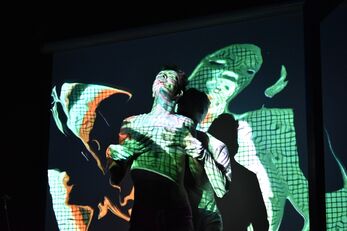
There are several projects that are on my mind. While attending this master’s program I’d like to challenge myself to pick up smaller projects that have a shorter timespan. Making films like ‘Release’ are heavy processes that take a lot of time, effort and involve a lot of people, money and parties.
With ‘There’s Something Behind Glass’ I experienced what it’s like to work on a smaller scale, in a shorter amount of time and more autonomous. So an intention I want to set is minimizing my cinematic practice in a way I need less money and people to create. In the future I’d like to research a more individual and guerilla way of creating images. An approach that can create more autonomy and less dependency.
But apart from my moving image work I’d like to expand my horizon, creating different outcomes which can also include still images, an installation or a performance. For my future research I want to dive more into topics such as generational trauma, addiction and healing. For this I want to use found footage of my own childhood while also researching a broader history of queer oppression and resistance, including different perspectives and theories which are not only from a western source.
Why do you want to make it?

A lot of my work has been limited to single screen media, which can be watched from everywhere, from a telephone to a cinema room. By visiting expositions with multimedia installations by Boogaerdt/VanderSchoot, Pipilotti Rist and Fiona Tan in TENT, Centraal Museum and EYE I have been inspired to look beyond my comfort zone. I want to focus more on using the notion of space in my work.
My goal is to be versatile in my practice, being a visual artist that has a box of tools in which they use the medium that resonates with the subject of focus. I’m aspiring to be a chameleon; using the medium that serves me in the moment. I also want to experiment with the notion of performativity more in my work and challenge traditional ways of storytelling. In this way I want my work to be playful as well, experimenting with the fourth wall and challenging the expectations of a spectator.
The way desire can move a human-being is a recurring theme in my work. It’s very visible in both of the works I’m writing about. There is a certain fascination for the more intimate parts of human life. I think the subconscious mind and our emotional world are the most fascinating parts to explore. The topics around trauma and recovering I’d like to focus on in the future arise from these interests. In a way I want my work to be a healing component itself, not (intentionally) for myself but for the participant that enters the work.
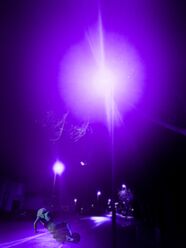
Apart from this I’m also invested in the experiences of marginalized communities since I feel these are the stories that matter. Being queer has given me the opportunity to tell stories from within our spaces and culture, ‘Release’ being a good example. Stories that challenge the status quo around gender, intimacy and culturally oppressed values.
Relation to a larger context
Thematically I resonate with other queer artists that try to uncover society’s demands and show the desires and stories within the community. Examples are David Wojnarowicz and Nan Goldin.
My focus on personal experiences and emotions aligns with the trend of autoethnographic storytelling, while my exploration of the queer community connects to the study of gender and sexuality in queer theory. I relate to other artists who used their personal experience as part of their work, such as Barbara Hammer and writer Ocean Vuong. In the future I’d like to focus on artists and writers who use healing and the (queer) body as a main theme in their work.
As I continue to evolve as an artist, I remain committed to using my practice to challenge dominant narratives and also question mainstream ways of producing images. I am dedicated to exploring innovative forms of storytelling, and finding new ways to express my own.
References:
- Double Act, 2023. [exhibition] Centraal Museum, Utrecht. 8 October 2022 - 15 January 2023
- Lacan, J. (1957-1958). Les formations de l'inconscient [The Formations of the Unconscious].
- Mountains and Molehills, 2022. [exhibition] Eye filmmuseum, Amsterdam. 2 October 2022 - 8 January 2023
- Tadic, A. 2023. KALEIDO: Queers in the lost city. [photograph]
- Traveling without moving, 2022. [exhibition] Tent Rotterdam. 16 September 2022 - 13 November 2022
- Wagenaar, A. and Horde, Y.de (2008) Bokito!: Het Complete Verhaal. Hilversum: Just Publishers.

